A sliding conducting bar of mass m resistance R is released from rest . It starts sliding due to the current drawn from a battery of emf ε in a steady inward magnetic field . Find the variation of its speed with time. Also find the terminal speed of the bar.
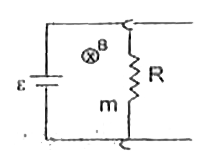
The correct Answer is:EBl
Step by step video, text & image solution for A sliding conducting bar of mass m resistance R is released from rest . It starts sliding due to the current drawn from a battery of emf epsilon in a steady inward magnetic field . Find the variation of its speed with time. Also find the terminal speed of the bar. by Physics experts to help you in doubts & scoring excellent marks in Class 12 exams.
Topper's Solved these Questions
- BOOK - FIITJEECHAPTER - ELECTROMAGNETIC INDUCTIONEXERCISE - ASSIGNMENT PROBLEMS ( OBJECTIVE ) LEVEL -I28videos
ELECTROMAGNETIC INDUCTION
- BOOK - FIITJEECHAPTER - ELECTROMAGNETIC INDUCTIONEXERCISE - ASSIGNMENT PROBLEMS (OBJECTIVE ) LEVEL -I1videos
ELECTROMAGNETIC INDUCTION
- BOOK - FIITJEECHAPTER - ELECTROMAGNETIC INDUCTIONEXERCISE - ASSIGNMENT PROBLEMS ( SUBJECTIVE ) Level -I True and False5videos
ELECTROMAGNETIC INDUCTION
- BOOK - FIITJEECHAPTER - ELASTICITY AND WAVES EXERCISE - Assignment Problems (Objective) Level-II15videos
ELASTICITY AND WAVES
- BOOK - FIITJEECHAPTER - ELECTROMAGNETIC INDUCTION AND AC CURRENTEXERCISE - Example15videos
ELECTROMAGNETIC INDUCTION AND AC CURRENT
Similar Questions
Calculate the current drawn from the battery of emf 15V and internal resistance 0.5Ω in the circuit shown in Fig. 6.12. Also find the power dissipated in thd 6Ω resistor.
 View Solution
View SolutionA metal wire of mass m sides without friction magnetic fields of induction B. A battery of constant emf ε is connected to the rails . What is the terminal speed of the slider ?
View Solution
Knowledge Check
- Question 1 - Select One
A conducting wire ab of length l resistance r and mass m starts sliding down at t=0 on a smooth, vertical thick pair of connected rails as shown. The terminal speed of the wire is
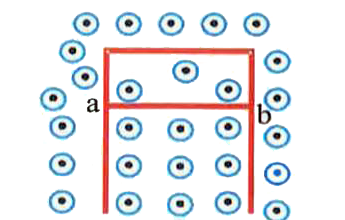 AmgRBlBmgrB2l2CmglB2r2DNone
AmgRBlBmgrB2l2CmglB2r2DNone - Question 2 - Select One
A conducting rod, with a resistor of resistance R. is pulled with constant speed v on a smooth conducting rail as shown in figure. A constant magnetic field →B is directed into the page. If the speed of the bar is doubled, by what factor does the rate of heat dissipation across the resistance R change?
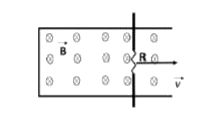 A0B√2C2D4
A0B√2C2D4
An inductance L and a resistance R are connected in series with a battery of emf epsilon. Find the maximum rate at which the energy is stored in the magnetic field.
View SolutionTwo long fixed parallel vertical conducting rails AB and CD are separated by a distance L. They are connected by resistance R and a capacitance C at two ends as shown in the figure. There is a uniform magnetic field B directed horizon- tally into the plane of the figure. A horizontal metallic bar of length L and mass m can slide without friction along the rails. The bar is released from rest at t = 0. Neglect resistance of bar and rails and also neglect the self inductance of the loop.
(a) Find the maximum speed acquired by the bar after it is released.
(b) Find the speed of the bar as a function of time t.
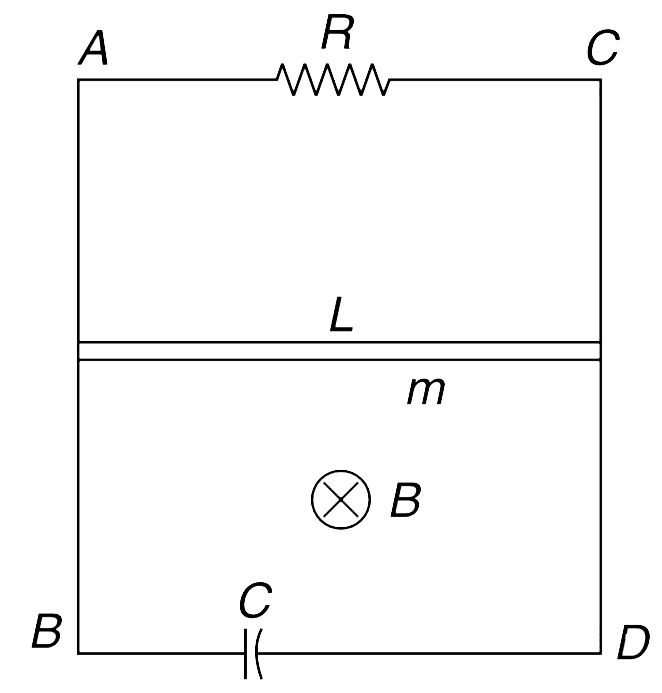 View Solution
View SolutionA conducting bar of sufficient length is pulled with a constant velocity in a conducting shaped rail as shown in the figure . Inward magnetic field of induction B is present inside the area bounded by the bar & the rail. Find the external power delivered in moving the rail with constant velocity v at time t ( A= area of cross section of the bar ρ= resistivity of the bar )
 View Solution
View SolutionA metal bar with length L , mass m and resistance R is polaced on frictionless metal rails that are inclined at an angle ϕ above the horizontal. The rails have negiligible resistance. There is a uniform magnetic field of nagnitude B direction download in the figure. The bar is released from rest and slide down the rails.
(a) Is the direction of the current induced in the bar from a and b or b to a ?
(b) What is the terminal speed of the bar ?
What is the induced current in the bar when the terminal speed has been reached ?
(d) After the terminal speed has been reached, at what rate is electrical energy being converted to thermal energy in the resistance of the bar ?
(e) After the terminal speed has been reached, at what rate is work being done on the bar by gravity? Compare your answer to that in part (d).
 View Solution
View SolutionA conducting rod, with a resistor of resistance R. is pulled with constant speed v on a smooth conducting rail as shown in figure. A constant magnetic field →B is directed into the page. If the speed of the bar is doubled, by what factor does the rate of heat dissipation across the resistance R change?
 View Solution
View SolutionThe block shown in figure is released from rest. Find out the speed of the block when the spring is compressed by 1 m
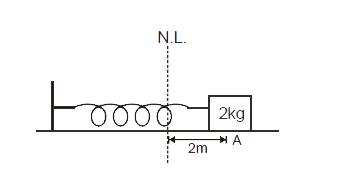 View Solution
View Solution

